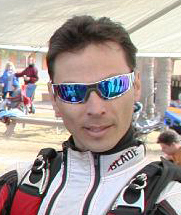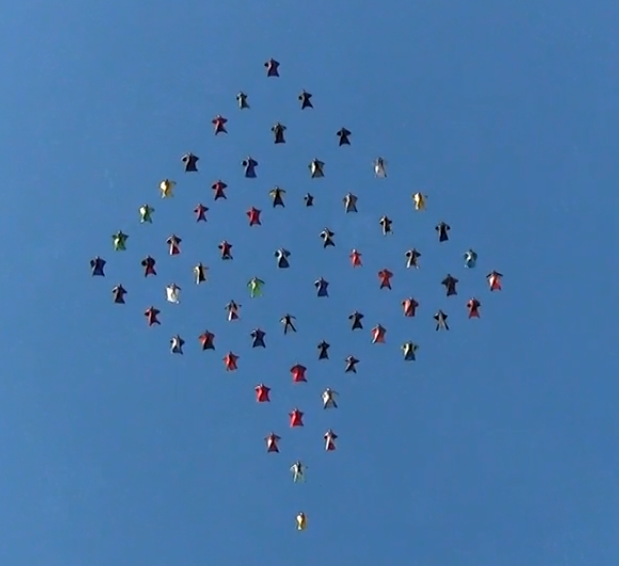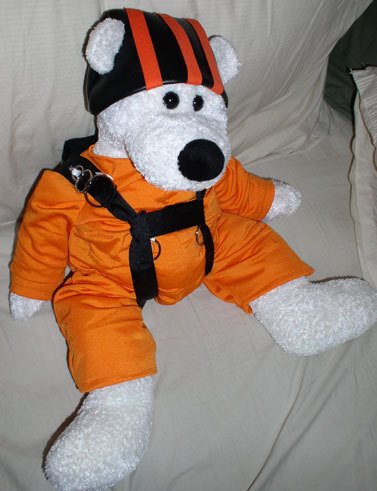Recommended Posts
kallend 2,231
QuoteI don't have any reports off hand that I can point you to for reference(I'm sure many could be googled) but having sat in the chamber many times and had phys techs as well as flight surgeons explain the medicne behind it to me each time, there is one thing I am sure of and have witnessed in a real environment. If the seal on your mask is compromised and you breath any ambient air you are not doing yourself any good as you are now introducing nitrogen back into your system and your potential for getting the bends and or other high altitude sicknesses increases exponetially.It's not based on military application or civillian, it's just the way physiology works( not that I am claiming to be a SME on it). Perhaps our Phys Tech friend will expound on anything I failed to mention or cover thoughly.
The whole purpose of having a mask that covers your mouth and nose is to avoid breathing in any ambient air while hooked up to O2. If your breathing ambient and O2 you aren't really doing yourself any good other than replacing your already rapidly depleted O2 in your system. It's much like leaving the engine running while filling the gas tank except the engine is burning gas as fast if not faster then the gas is being added. The added danger is that the guy pumping the gas is holding a blow torch called nitrogen in his other hand.
IMO, the best way to approach this for civillian skydiving that is agreeable from both a cost as well as a safety standpoint is to use only full face(nose and mouth) masks on aviation quality O2 with skydivers starting breathing at 8000 feet with a ceiling(exit altitude) no higher than 17999 and duration of time at altitude no longer than necessary. In an ideal situation, A/C permitting, the base would have a smaller console or bottle positioned near the door for the sole purpose of allowing them to stay on O2 for as long as possible while positioning or even have their own bail out bottles inside their jumpsuit that they could switch to during climb out.
I know this brings other issues like helmets into play and divers and so on and there are several different ways to skin that cat but I won't dillute this topic with them.
What is the difference between aviator's oxygen, medical oxygen, and welders oxygen?
Doesn't the FAA allow cannulas to 25k?
The only sure way to survive a canopy collision is not to have one.
O2 Information
Some people dream about flying, I live my dream
SKYMONKEY PUBLISHING
kallend 2,231
QuoteHere is a good read to answer your questions and many more about this topic.
O2 Information
Thanks - seems like all O2 is the same except in the eyes of your insurer, cannulas are good to 18k, and the bends is only a problem with fast climbing aircraft going above 20k in less than 20 minutes (Mullins' King Air?)
The only sure way to survive a canopy collision is not to have one.
quade 4
Medical O2 has a higher moisture content. My guess is so that it's more tolerable for long term usage as it helps avoid the dry mouth, nose and throat.
Industrial (welder's) O2 can have a higher level of impurities that may be harmful to humans.
More info HERE.
The World's Most Boring Skydiver
billvon 3,176
>at altitudes as low as 8000 feet. Its well documented in even primary
> pilots training especially in regards to flying at night.
Interesting, in that pilots are not required to use it below 12,500 and many aircraft cabins are only pressurized to 10,000 feet - and the pilots breathe cabin air in those aircraft.
billvon 3,176
So the primary concern above 18,000 feet (assuming the jumper is on the FAA-recommended O2 flows) is decompression sickness? Interesting.
quade 4
As for the requirement for pilots above 12,500 -- inducing symptoms and affecting safety of flight are two different numbers. There's also the amount of exposure and amount of activity to be considered as well.
Further, I've always been amazed by the guys that climb mountains without O2. It's one thing to be off it for a few seconds in the door waiting for exit and another thing entirely climbing up the side of a mountain at 18,000 msl.
The World's Most Boring Skydiver
quade 4
QuoteSo the primary concern above 18,000 feet (assuming the jumper is on the FAA-recommended O2 flows) is decompression sickness? Interesting.
No, I don't think that's quite right.
Certainly at some point and with some rapidity of accent that's an issue and above about 60,000 feet all sorts of nasty things happen without a pressure suit, but I would have to say that the main issue at levels between say 8,000 to 30,000 are lack of O2 to the brain.
After all, if you began to get nitrogen bends at 24,000 all you'd really have to do to get rid of them would be to descend. However, if you lost consciousness, well, that's another story entirely -- you wouldn't be able to take corrective action because, well, you'd be unconscious.
The World's Most Boring Skydiver
faulknerwn 38
Quote. If the seal on your mask is compromised and you breath any ambient air you are not doing yourself any good as you are now introducing nitrogen back into your system and your potential for getting the bends and or other high altitude sicknesses increases exponetially.It's not based on military application or civillian, it's just the way physiology works( not that I am claiming to be a SME on it). Perhaps our Phys Tech friend will expound on anything I failed to mention or cover thoughly.
Interesting. I did the chamber when I was in Brazil a few years ago. Being of smaller build, and the fact that it was a military chamber, we had trouble finding masks which fit me. It took a long time to fit me at the beginning, and after I had removed the mask and put it back on in the chamber - it wasn't quite sealed right. I stayed somewhat dizzy unless I held it on tightly to my face - by holding it on I was ok, but I still felt pretty weird for a good portion of the day. I wonder if my reaction had to do with not having a good seal on the mask?
Interestingly enough - the Brazilian military was going to make us wear oxygen to go to 15k. And not only that - but we would have to pre-breathe oxygen for some amount of time, and the oxygen setup we had to wear was pretty much a full pilot-style hard helmet - with a mask that covered your whole nose and mouth (well in my case my entire face!) We weren't particularly upset when the C130 blew an engine and we had to do only 13k jumps out of a different plane.
W
QuoteFurther, I've always been amazed by the guys that climb mountains without O2. It's one thing to be off it for a few seconds in the door waiting for exit and another thing entirely climbing up the side of a mountain at 18,000 msl.
In Mt. climbing it is generally recommended that one not ascend more than a 1000 ft. in a day when at altitude, which is why many camps are set up and several trips are made up only to come back down and then continue higher. This allows the body to better adapt to the stress of less O2 during excertion over a period of time. As a side note this theroy is also being used by atheletes in sealed rooms that allows them to "sleep high" and train low for better O2 absorbtion and usage at lower levels(read normal)
Another bag of worm I didn't want to open and it was mentioned in the article I referenced is types of systems(consoles), Constant flow and on demand and the regulation of the flow to individual jumpers. All I've seen on civillian O2 jumps is one big bottle usually under the seat or by the pilot and all the medical sized lines running off of it. I'm pretty sure the guy furthest from the bottle isn't getting the same flow as the guy next to it unless there is a prett good regulation system on it. When you get to the really high altitudes the O2 can come out of the mask like compressed air and can be a challenge to breath if you open your mouth and breath in as it literally fills your lungs up instantly. The thing to remember is the EPT given are for pilots sitting in an A/C, not skydivers moving around and getting amped about the dive. Throw in smoking, hangovers, sickness , or general poor health and it gets even lower on the EPT scale very quickly.
Some people dream about flying, I live my dream
SKYMONKEY PUBLISHING
quade 4
The World's Most Boring Skydiver
To my knowledge there are no "civilian consoles". The ones we use at AERO are six man conex systems and our masks have demand reg. on them. If you go above 43000 msl you need pressure breathing equipment to force O2 in and above 62-63000 msl you need a pressure suit, ie space suit or your blood will boil. At 25000 your time of useful consciousness is measured in just min. and at 30000 it is measured in sec. Above 18000 and surely above 24000 is not a game it serious and dangerous. Once you are at altitude you can have a leak in your mask because the nitrogen you breath will not expand unless you go higher.
Sparky
Sparky
QuoteTo my knowledge there are no "civilian consoles". The ones we use at AERO are six man conex systems and our masks have demand reg. on them
The AirForce and the Army are slowly changing over from the MBU-12 to the PHAOS system, although it has limited usage approval right now, some units are curently using it. But the MBU-12 system is still widely encountered. I'm assuming the console you are familiar with is the one manufactured by para flight, as are all military HALO parachutes and other equipment.
I think the consoles and masks are available to the public from para flite or something very close to it as it is used for commercial aviation in some situations.
[/url]http://www.paraflite.com/html/oxygen1.html
http://www.paraflite.com/html/oxygen2.html[url]
Just found my FM31-19 Military free fall parachuting manual.
Oxygen forms:
Gaseous oxygen: Gaseous aviator's breathing oxygen is designated Grade A, Type I, Military Spec MIL-0-27210E. No other manufactured O2 is acceptable. The difference between aviator's and medical or technical (welders) O2 is the absence of water vapor. The purity reqs for for aviators O2 is 99.5% by volume. I tmay not contain more than 0.0005 milligram of water vapor per liter at 760 millimeters of mercury and 68 degrees F. I t must be odorless and free from contaminates, including drying agents.
gaseous-Low pressure :Low pressure aviators breathing O2 is stored in yellow, light weight shatterproof cylinders. They are filled to a max pressure of 450psi and are considered empty when at 100psi.
Gaseous-high pressure: High pressure aviators breathing O2 is stored in lime green , heavy weight ,shatterproof bottles stenciled with AVIATORS BREATHING OXYGEN. They can be filled to a max pressure of 2200psi.
LIQUID OXYGEN: Liquid aviators O2 is designated Grade B , type II, MIL SPEC MIL-0-27210E. LOX's most common usage is in storage facilities and for aircraft oxygen supplies because a large quantity can be carried in a small space.
* All personnel will prebreath 100 % O2 at or below 10,000 feet MSL pressure or cabin altitude below 10,000 feet MSL pressure on any mission scheduled to drop at or above 18,000 feet MSL
* The required prebreathing time will be completed before the 20 min warning and before the cabin altitude ascends through 10,000 feet MSL.
* A break in prebreathing requires restarting the prebreathing period or removing the individual from the jump.
* prebreathing requires the presence of an AF phys tech onboard the A/C
* all personnel onboard during unpressurized operations above 10,000 feet MSL and higher will use O2(exception: parachutists may operate without supplental O2 during unpressurized flights up to 13,000 feet MSL provided the time above 10,000 feet MSL does not exceed 30 mins each sortie)
There is a catchy table describing the requirements but I'll post the one most like ly to be used by civillian jumpers.
Deplyment altitude: At or above 13,000 feet MSL but Below 18,000 feet MSL: ONboard O2: Supplemental O2 at normal before ascending through 10,000 feet MSL or cabin altitude; HALO ops: Supplemental O2 at normal from 1 min warning until canopy deployment below 10,000 feet MSL
notes: 1: Supplemental O2 means each jumper will have his own O2 mask and regulator
2: All prebreathing will be conducted at or below 10,000 feet MSL or 10,000 feet MSL cabin pressure.
At or above 18,000 feet MSL up to 25,000 feet MSL requires 100% O2 for 30 mins and from 1 min warning until canopy deplyment below 10,000 feet MSL
Some people dream about flying, I live my dream
SKYMONKEY PUBLISHING
Quote>It is common knowledge the effects of hypoxia can induce symtoms
>at altitudes as low as 8000 feet. Its well documented in even primary
> pilots training especially in regards to flying at night.
Interesting, in that pilots are not required to use it below 12,500 and many aircraft cabins are only pressurized to 10,000 feet - and the pilots breathe cabin air in those aircraft.
Bill this in regards to flying at night and these symtoms are milder than the blue finger tingling and sluggish lacking motor skills. We are talking about night peripheral vision and color recognition.
These are some of the benign symtoms which may have an effect at night. Sometimes these effects are made worse by caffiene. People are very different it is hard to predict how someone will react to partial gas pressures. So a safety margin for many may very well exclude a few individuals who process O2 differently.
Zenister 0
what do the physical O2 requirements mean for high altitude wingsuit flight? is it feasible with bottles and does the wingsuit 'work' well enough to be worth the effort & risks at higher altitudes?
i've wondered about high altitude wingsuits the instant i got down from my flight
Those who fail to learn from the past are simply Doomed.


.thumb.jpg.4bb795e2eaf21b8b300039a5e1ec7f92.jpg)



The whole purpose of having a mask that covers your mouth and nose is to avoid breathing in any ambient air while hooked up to O2. If your breathing ambient and O2 you aren't really doing yourself any good other than replacing your already rapidly depleted O2 in your system. It's much like leaving the engine running while filling the gas tank except the engine is burning gas as fast if not faster then the gas is being added. The added danger is that the guy pumping the gas is holding a blow torch called nitrogen in his other hand.
IMO, the best way to approach this for civillian skydiving that is agreeable from both a cost as well as a safety standpoint is to use only full face(nose and mouth) masks on aviation quality O2 with skydivers starting breathing at 8000 feet with a ceiling(exit altitude) no higher than 17999 and duration of time at altitude no longer than necessary. In an ideal situation, A/C permitting, the base would have a smaller console or bottle positioned near the door for the sole purpose of allowing them to stay on O2 for as long as possible while positioning or even have their own bail out bottles inside their jumpsuit that they could switch to during climb out.
I know this brings other issues like helmets into play and divers and so on and there are several different ways to skin that cat but I won't dillute this topic with them.
Some people dream about flying, I live my dream
SKYMONKEY PUBLISHING
Share this post
Link to post
Share on other sites